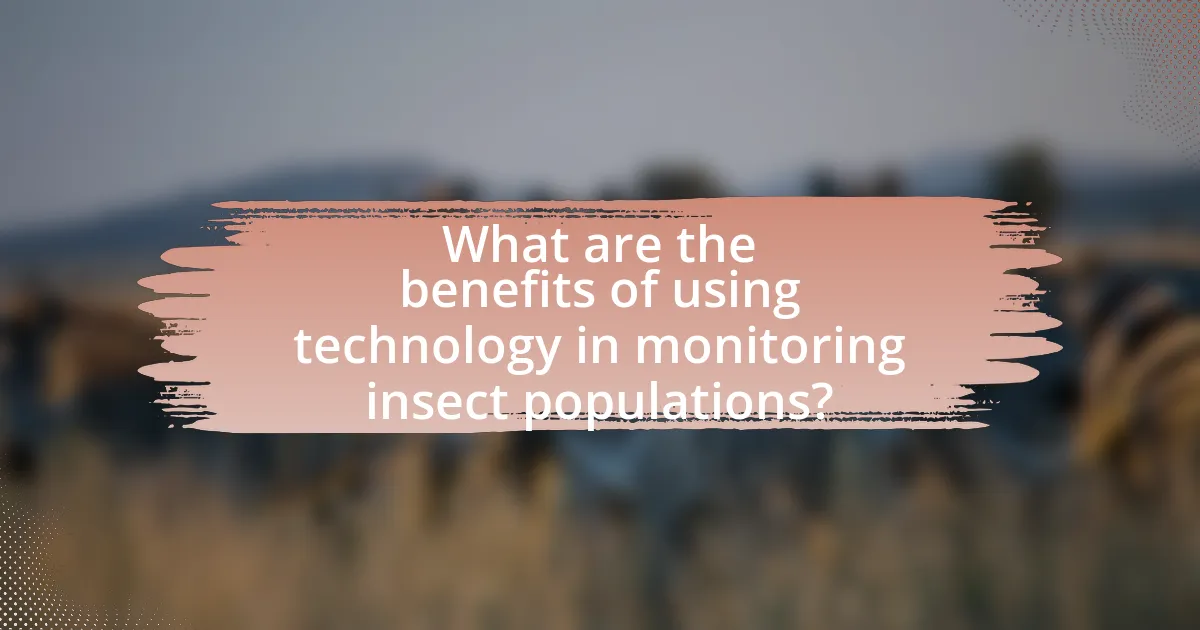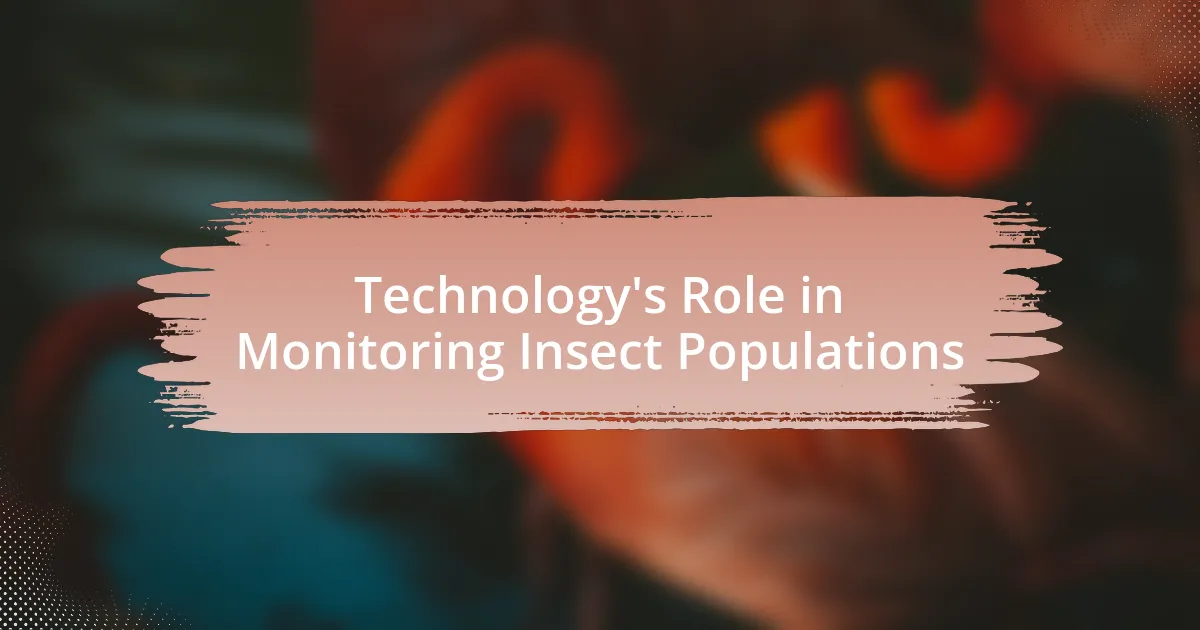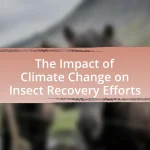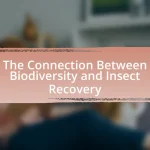Technology plays a vital role in monitoring insect populations through advanced tools such as remote sensing, data analytics, and automated traps. These innovations enable researchers to collect real-time data on insect distribution, behavior, and population dynamics, improving the efficiency and accuracy of monitoring efforts. Key advancements include the use of drones for large-scale habitat monitoring, machine learning algorithms for data analysis, and automated traps for continuous population tracking. Monitoring insect populations is essential for assessing ecosystem health, informing conservation strategies, and enhancing agricultural pest management practices. The integration of citizen science and AI is expected to further enhance data collection and analysis in future monitoring initiatives.
What is Technology’s Role in Monitoring Insect Populations?
Technology plays a crucial role in monitoring insect populations by utilizing advanced tools such as remote sensing, data analytics, and automated traps. These technologies enable researchers to collect real-time data on insect distribution, behavior, and population dynamics. For instance, remote sensing technologies, including drones and satellite imagery, allow for large-scale monitoring of habitats and can identify changes in insect populations due to environmental factors. Additionally, automated traps equipped with sensors can capture and identify insect species, providing accurate population counts and trends. Studies have shown that these technological advancements improve the efficiency and accuracy of monitoring efforts, leading to better-informed conservation strategies and pest management practices.
How has technology evolved in the context of insect population monitoring?
Technology has significantly evolved in insect population monitoring through advancements in remote sensing, data analytics, and automated systems. Remote sensing technologies, such as drones and satellite imagery, enable researchers to gather large-scale data on insect habitats and distributions with high precision. For instance, the use of drones equipped with multispectral cameras allows for the identification of vegetation types that support specific insect populations, enhancing ecological studies.
Additionally, data analytics tools, including machine learning algorithms, have improved the ability to analyze complex datasets, leading to more accurate predictions of population trends and behaviors. For example, studies have shown that machine learning can classify insect species based on acoustic signals, providing a non-invasive monitoring method.
Furthermore, automated traps and sensors have been developed to continuously monitor insect populations in real-time, reducing the need for manual counting and increasing data collection efficiency. These innovations collectively enhance the accuracy and efficiency of insect population monitoring, facilitating better management and conservation strategies.
What are the key technological advancements that have impacted this field?
Key technological advancements that have impacted the field of monitoring insect populations include remote sensing, automated traps, and machine learning algorithms. Remote sensing technologies, such as satellite imagery and drones, allow for large-scale habitat monitoring and mapping of insect populations, providing critical data on distribution and density. Automated traps equipped with sensors and cameras enable real-time data collection and species identification, significantly increasing the efficiency of monitoring efforts. Machine learning algorithms analyze vast datasets to identify patterns and predict population trends, enhancing the understanding of ecological dynamics. These advancements collectively improve the accuracy and efficiency of insect population monitoring, facilitating better management and conservation strategies.
How do these advancements improve data collection and analysis?
Advancements in technology enhance data collection and analysis by enabling more precise and efficient monitoring of insect populations. For instance, the use of remote sensing technologies, such as drones and satellite imagery, allows researchers to gather large-scale data on insect habitats and behaviors with minimal human intervention. This method significantly reduces the time and labor required for traditional field surveys. Additionally, machine learning algorithms can analyze vast datasets quickly, identifying patterns and trends that would be difficult for humans to discern. A study published in the journal “Ecological Applications” demonstrated that automated image recognition systems could classify insect species with over 90% accuracy, showcasing the effectiveness of these advancements in improving data reliability and speed.
Why is monitoring insect populations important?
Monitoring insect populations is important because it provides critical data for assessing ecosystem health and biodiversity. Insects play essential roles in pollination, nutrient cycling, and as food sources for other wildlife; thus, their population dynamics can indicate broader environmental changes. For instance, studies have shown that declines in insect populations can lead to reduced pollination services, impacting agricultural yields and natural plant communities. Furthermore, monitoring can help identify invasive species and track the spread of pests, enabling timely management interventions. This data-driven approach is vital for conservation efforts and sustainable agricultural practices, ensuring ecosystem resilience and food security.
What ecological roles do insects play that necessitate monitoring?
Insects play crucial ecological roles that necessitate monitoring, including pollination, decomposition, and serving as food sources for other organisms. Pollinators, such as bees and butterflies, are responsible for the fertilization of approximately 75% of flowering plants, which is vital for food production and ecosystem health. Decomposers, like beetles and ants, break down organic matter, recycling nutrients back into the soil, which supports plant growth. Additionally, insects are integral to food webs, providing sustenance for birds, mammals, and other wildlife. Monitoring these roles is essential to assess ecosystem health, track biodiversity, and identify changes due to environmental stressors, such as habitat loss and climate change.
How does insect population monitoring contribute to agriculture and pest management?
Insect population monitoring significantly enhances agriculture and pest management by providing critical data that informs decision-making. This monitoring allows farmers to identify pest outbreaks early, enabling timely interventions that can reduce crop damage and minimize pesticide use. For instance, studies have shown that integrated pest management strategies, which rely on accurate insect population data, can lead to a 30-50% reduction in pesticide applications while maintaining crop yields. Additionally, monitoring helps in understanding pest life cycles and behaviors, allowing for the development of targeted control measures that are more effective and environmentally sustainable.
What technologies are commonly used in monitoring insect populations?
Common technologies used in monitoring insect populations include remote sensing, acoustic monitoring, and automated traps. Remote sensing utilizes satellite imagery and drones to assess habitat conditions and insect distribution over large areas. Acoustic monitoring employs sound recording devices to detect and identify insect calls, providing insights into species presence and behavior. Automated traps, equipped with sensors and cameras, capture insects and collect data on their abundance and diversity, facilitating real-time monitoring. These technologies enhance the accuracy and efficiency of insect population assessments, supporting ecological research and pest management strategies.
What role do drones play in insect monitoring?
Drones play a crucial role in insect monitoring by providing high-resolution aerial imagery and data collection capabilities. These unmanned aerial vehicles can cover large areas quickly, allowing researchers to identify and track insect populations, assess their habitats, and monitor changes over time. For instance, studies have shown that drones equipped with multispectral cameras can detect specific plant stress indicators that correlate with insect infestations, enabling targeted pest management strategies. Additionally, drones facilitate the collection of data in hard-to-reach areas, enhancing the accuracy and efficiency of insect monitoring efforts.
How do sensor technologies enhance insect tracking and data collection?
Sensor technologies enhance insect tracking and data collection by providing precise, real-time monitoring capabilities. These technologies, such as RFID tags, GPS trackers, and environmental sensors, allow researchers to gather extensive data on insect movements, behaviors, and interactions with their environments. For instance, RFID tags can be attached to insects to track their locations and movements over time, enabling the analysis of migration patterns and habitat use. Additionally, environmental sensors can collect data on temperature, humidity, and other factors that influence insect activity, facilitating a comprehensive understanding of their ecological roles. Studies have shown that using these technologies can significantly improve data accuracy and the ability to monitor insect populations effectively, leading to better conservation strategies and pest management practices.
How do researchers utilize data from insect monitoring technologies?
Researchers utilize data from insect monitoring technologies to assess biodiversity, track population dynamics, and inform conservation strategies. By employing tools such as automated traps, acoustic sensors, and remote sensing, researchers can gather real-time data on insect abundance and distribution. For instance, studies have shown that using automated traps can increase the accuracy of population estimates by up to 30%, allowing for more effective management of pest species and pollinators. This data is crucial for understanding ecological interactions and the impacts of environmental changes on insect populations, thereby guiding policy decisions and conservation efforts.
What challenges do researchers face in implementing these technologies?
Researchers face significant challenges in implementing technologies for monitoring insect populations, primarily due to data accuracy and integration issues. The complexity of insect behavior and environmental variability can lead to inconsistent data collection, making it difficult to obtain reliable results. Additionally, researchers often struggle with the integration of diverse technological tools, such as remote sensing and data analytics platforms, which can hinder effective monitoring. For instance, a study published in the journal “Ecological Applications” highlights that discrepancies in data formats and standards can complicate the synthesis of information from different sources, ultimately affecting the quality of insights derived from the data.

What are the benefits of using technology in monitoring insect populations?
The benefits of using technology in monitoring insect populations include enhanced data accuracy, real-time tracking, and improved efficiency in data collection. Technologies such as remote sensing, drones, and automated traps allow researchers to gather precise population metrics and behavioral patterns without disturbing the insects. For instance, studies have shown that drone technology can cover large areas quickly, providing high-resolution images that help identify insect habitats and population densities. Additionally, automated data collection systems reduce human error and labor costs, enabling continuous monitoring and timely responses to population changes. These advancements contribute to better pest management strategies and ecological research, ultimately supporting biodiversity conservation efforts.
How does technology improve accuracy in insect population assessments?
Technology enhances accuracy in insect population assessments through advanced data collection and analysis methods. Tools such as remote sensing, automated traps, and machine learning algorithms enable researchers to gather large datasets with minimal human error. For instance, remote sensing can monitor habitat changes and insect distributions over vast areas, while automated traps can consistently capture insects without bias. Machine learning algorithms analyze these datasets to identify patterns and predict population trends, improving the reliability of assessments. Studies have shown that these technological advancements can increase the precision of population estimates by up to 30%, demonstrating their significant impact on entomological research.
What specific technologies provide the most accurate data?
Remote sensing technologies, such as satellite imagery and drones, provide the most accurate data for monitoring insect populations. These technologies enable high-resolution data collection over large areas, allowing researchers to track changes in habitat and population dynamics effectively. For instance, studies have shown that satellite imagery can detect vegetation changes that correlate with insect population fluctuations, while drones can capture detailed images of specific habitats, enhancing the precision of population assessments.
How does real-time data collection impact decision-making in pest management?
Real-time data collection significantly enhances decision-making in pest management by providing immediate insights into pest populations and their behaviors. This immediacy allows pest managers to respond swiftly to infestations, optimizing control measures and resource allocation. For instance, studies have shown that real-time monitoring systems can reduce pesticide use by up to 30% by enabling targeted interventions based on actual pest presence rather than generalized predictions. Furthermore, real-time data facilitates the identification of pest trends and patterns, allowing for proactive management strategies that can prevent outbreaks before they escalate.
What cost benefits does technology offer in insect monitoring?
Technology offers significant cost benefits in insect monitoring by enhancing data collection efficiency and reducing labor costs. Automated systems, such as remote sensing and smart traps, minimize the need for manual inspections, which can be time-consuming and expensive. For instance, the use of drones for aerial surveys can cover large agricultural areas quickly, allowing for real-time data acquisition that traditional methods cannot match. This efficiency translates to lower operational costs, as fewer personnel are required for monitoring tasks. Additionally, data analytics tools can process vast amounts of information rapidly, leading to quicker decision-making and potentially reducing crop losses due to pest infestations. Studies have shown that integrating technology in pest management can lead to cost savings of up to 30% in some agricultural settings, demonstrating the financial advantages of adopting these innovations.
How does automation reduce labor costs in monitoring efforts?
Automation reduces labor costs in monitoring efforts by streamlining data collection and analysis processes, which minimizes the need for manual labor. Automated systems, such as drones and sensors, can continuously monitor insect populations without the need for human intervention, significantly decreasing the workforce required for these tasks. For instance, a study published in the journal “Ecological Applications” demonstrated that using automated traps reduced the labor costs associated with monitoring insect populations by up to 50%, as these systems can operate around the clock and cover larger areas more efficiently than human workers.
What are the long-term financial benefits of investing in monitoring technology?
Investing in monitoring technology yields long-term financial benefits by enhancing efficiency, reducing costs, and improving decision-making in managing insect populations. For instance, precise monitoring allows for targeted pest control, which can decrease pesticide expenses by up to 30%, as demonstrated in agricultural studies. Additionally, effective monitoring can lead to increased crop yields, with reports indicating that farmers utilizing such technology can see yield improvements of 10-20%. This not only boosts revenue but also contributes to sustainable practices, reducing the long-term financial risks associated with environmental regulations and market fluctuations.

What future trends can we expect in technology for monitoring insect populations?
Future trends in technology for monitoring insect populations include the increased use of artificial intelligence (AI) and machine learning algorithms to analyze data collected from various sources. These technologies enable researchers to process large datasets from sensors, cameras, and drones more efficiently, allowing for real-time monitoring and predictive modeling of insect behavior and population dynamics. For instance, studies have shown that AI can improve species identification accuracy by over 90% when analyzing images captured in the field. Additionally, advancements in remote sensing technologies, such as satellite imagery and IoT devices, will facilitate the tracking of insect populations across vast areas, providing critical insights into their habitats and migration patterns.
How might artificial intelligence shape the future of insect monitoring?
Artificial intelligence will significantly enhance insect monitoring by enabling real-time data analysis and pattern recognition. AI algorithms can process vast amounts of data from various sources, such as sensors, cameras, and drones, to identify insect species, track their populations, and monitor their behaviors with high accuracy. For instance, a study published in the journal “Nature” demonstrated that machine learning models could classify insect species from images with over 90% accuracy, showcasing AI’s potential in automating and improving monitoring efforts. This capability allows researchers and conservationists to respond more effectively to changes in insect populations, which are critical for ecosystem health and agricultural productivity.
What potential applications of AI could enhance data analysis?
AI can enhance data analysis through applications such as predictive modeling, anomaly detection, and natural language processing. Predictive modeling utilizes machine learning algorithms to forecast insect population trends based on historical data, enabling researchers to anticipate changes and implement timely interventions. Anomaly detection algorithms can identify unusual patterns in insect behavior or population dynamics, which may indicate environmental changes or emerging threats. Natural language processing can analyze vast amounts of unstructured data from research papers and field reports, extracting relevant insights that inform data-driven decisions. These applications collectively improve the accuracy and efficiency of data analysis in monitoring insect populations.
How can machine learning improve predictive modeling of insect populations?
Machine learning can improve predictive modeling of insect populations by analyzing large datasets to identify patterns and trends that traditional methods may overlook. For instance, machine learning algorithms can process environmental variables, historical population data, and climate factors to create more accurate models of population dynamics. Research has shown that models incorporating machine learning techniques, such as random forests and neural networks, can significantly enhance prediction accuracy compared to conventional statistical methods. A study published in the journal “Ecological Modelling” demonstrated that machine learning approaches outperformed traditional models in forecasting the population fluctuations of specific insect species, highlighting their effectiveness in ecological predictions.
What role will citizen science play in future insect monitoring efforts?
Citizen science will play a crucial role in future insect monitoring efforts by enabling large-scale data collection and enhancing public engagement in biodiversity conservation. This approach allows non-experts to contribute valuable observations and data on insect populations, which can significantly increase the volume and geographic coverage of monitoring efforts. For instance, projects like the North American Butterfly Association’s Butterfly Count have demonstrated that citizen-collected data can complement scientific research, providing insights into population trends and distribution changes. Furthermore, studies have shown that citizen science initiatives can lead to increased awareness and education about insect conservation, fostering a community-driven approach to environmental stewardship.
How can technology facilitate public participation in monitoring initiatives?
Technology facilitates public participation in monitoring initiatives by providing accessible platforms for data collection and sharing. Mobile applications and online databases enable citizens to report insect sightings, contributing valuable data to scientific research. For instance, platforms like iNaturalist allow users to upload observations, which are then verified by experts, creating a collaborative database that enhances monitoring efforts. Additionally, social media can be utilized to raise awareness and engage communities in monitoring activities, fostering a sense of ownership and responsibility towards local ecosystems. This participatory approach not only enriches data quality but also empowers individuals to contribute to scientific knowledge and conservation efforts.
What are the benefits of integrating citizen data with professional research?
Integrating citizen data with professional research enhances the quality and scope of scientific studies, particularly in monitoring insect populations. Citizen data provides large-scale, real-time observations that complement professional research, allowing for more comprehensive datasets. For instance, studies have shown that citizen scientists can contribute valuable information on species distribution and behavior, which can lead to more accurate assessments of insect population trends. A notable example is the “Bumblebee Conservation Trust” project, where citizen-reported sightings significantly improved understanding of bumblebee populations across the UK. This integration not only increases data volume but also fosters community engagement and awareness, ultimately leading to more informed conservation strategies.
What practical tips can researchers follow to effectively use technology in monitoring insect populations?
Researchers can effectively use technology in monitoring insect populations by employing automated traps equipped with sensors and cameras. These devices can capture real-time data on insect activity and diversity, significantly reducing the need for manual counting and identification. For instance, studies have shown that using image recognition software can increase the accuracy of species identification by up to 90%, allowing for more reliable population assessments. Additionally, integrating geographic information systems (GIS) can help researchers analyze spatial patterns and habitat preferences, enhancing their understanding of ecological dynamics. By utilizing these technologies, researchers can streamline data collection processes and improve the overall efficiency of monitoring efforts.


